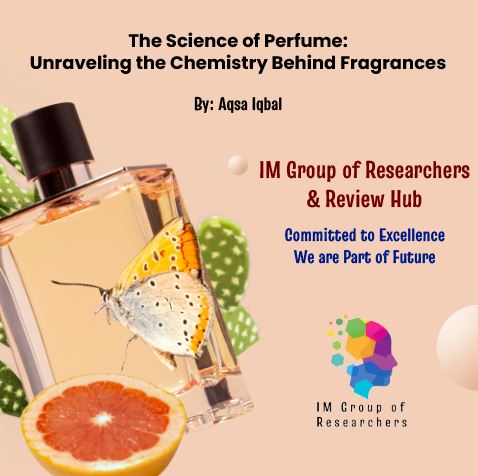Perfume has been an integral part of human culture for centuries, captivating our senses and leaving a lasting impression. Behind the enchanting scents lies a fascinating world of chemistry, where compounds and molecules come together to create unique and alluring fragrances. In this article, we’ll delve into the science of perfume, exploring the key components, extraction methods, and the intricate chemistry that makes each scent a work of art.
Author
Aqsa Iqbal

LinkedIn: Click here to see Aqsa’s profile
The science of perfume is a captivating fusion of art and chemistry, where passion and precision converge to create an olfactory masterpiece. As we unravel the secrets behind fragrances, we gain a newfound appreciation for the intricate dance of molecules that enchants our senses. Whether you’re a seasoned perfumista or a curious novice, the science of perfume invites you to inhale deeply, savor the complexity, and appreciate the alchemy that transforms liquid into a symphony for the senses.
Essential Oils and Aromatics:
At the heart of every perfume lies essential oils, extracted from a myriad of plants and botanicals. The extraction methods, whether through steam distillation, cold pressing, or solvent extraction, capture the essence of nature. Imagine fields of lavender, citrus groves, and exotic flowers, each contributing its unique aroma to the perfumer’s palette.
Chemical Components of Perfume:
The magic of perfume lies in its composition, meticulously crafted to unfold in layers. Comprising top, middle, and base notes, perfumes are a harmonious blend of various chemical compounds. Terpenes, esters, aldehydes, and countless other molecules come together to create the characteristic scents that define different fragrance families. From the fleeting top notes that greet us initially to the enduring base notes that linger, the chemistry of perfume is a carefully orchestrated dance of molecules, creating a sensory experience that evolves over time
The Olfactory System:
Our sense of smell is a powerful yet often underrated aspect of human perception. The olfactory system, intricately connected to the brain’s limbic system, processes scents and forges a link between fragrance and memory. This connection is why a particular perfume can evoke emotions or transport us to a specific time and place. As we explore the science of perfume, we uncover the profound impact fragrance can have on our emotions and memories, adding another layer to its complexity.
Fragrance Families and Classifications:
Perfumes are classified into various families based on their dominant notes – floral, fruity, oriental, woody, and more. Each family has its characteristic scent profile, offering a diverse range of options to suit individual preferences. Understanding these families and the concentration of fragrance (eau de toilette, eau de parfum, etc.) allows consumers to make informed choices, ensuring the right balance between subtlety and longevity.
The Art of Perfume Blending:
Perfumers, akin to skilled alchemists, possess the artistry to blend numerous components into a harmonious and unique fragrance. Balancing top, middle, and base notes, they create olfactory masterpieces that captivate the senses. This skillful blending is the true art of perfumery, where creativity and precision converge.
Synthetic vs. Natural Fragrances:
EThe debate between synthetic and natural fragrances adds another layer to the science of perfume. While natural ingredients evoke a sense of authenticity and luxury, synthetic compounds offer consistency and new possibilities. The balance between the two is a dynamic aspect of modern perfumery, reflecting the industry’s continual evolution.
Perfume and Cultural Significance:
Perfume transcends mere sensory pleasure; it carries cultural and historical significance. Throughout the ages, different civilizations have embraced perfumes for rituals, ceremonies, and personal adornment. Iconic perfumes have become cultural symbols, leaving an enduring legacy.
Innovations in Perfumery:
In a rapidly evolving world, perfumers embrace innovation. Explore cutting-edge advancements, from sustainable practices to novel extraction technologies, shaping the future of perfumery and ensuring its longevity in a changing landscape.
Perfume Packaging and Presentation:
Beyond the liquid within, the artistry of perfume extends to its packaging. Delve into the psychology of perfume presentation, where aesthetics and branding intertwine to create a sensory experience that begins with the eyes and ends with the nose.
Also read: Ensuring Authenticity A Powerful Detector for AI-Generated Text in Chemistry Papers
Follow Us on

